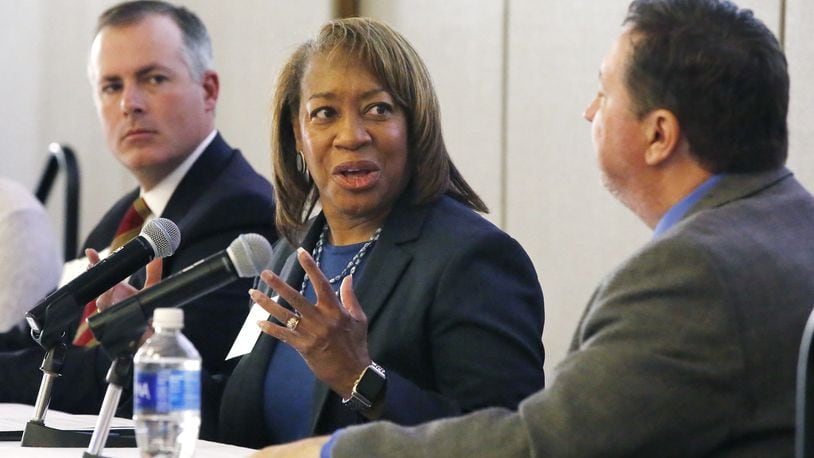“That says a lot about collective effort. No one community partner owns this. It takes the entire group of us to come together and collaborate in a way that makes a difference,” said panelist Helen Jones-Kelley, executive director of Alcohol, Drug Addiction and Mental Health Services Board of Montgomery County.
RELATED: Montgomery County to start treating opioid addiction with new program
The panel discussion was part of a regional conference held Thursday by Impact Ohio held at Sinclair Community College.
The conference, sponsored by the Dayton Daily News, The Success Group and the Dayton Area Chamber of Conference, was held to explore policy and politics important to the region.
State. Rep. Robert Sprague, R-Findlay, and state Rep. Jeff Rezabek, R-Clayton, also joined Jones-Kelley on the panel.
Jones-Kelley said one example of an effort making a big difference is the Community Overdose Action Team, which was started last fall. The inter-agency model has eight different divisions that look at addressing different aspects of addiction like prevention, treatment and recovery.
The collaborative involves more than 300 people from 100 different organizations.
RELATED: $2M federal grant to aid Montgomery County opioid overdose response
“This is one of those times when we can honestly say that when we said ‘all hands on deck’ that all hands showed up,” she said.
Multiple attendees submitted questions about what legalized medical marijuana could mean for the opioid epidemic, which has roots in the over-prescription of high power painkillers.
Rezabek said the state will need to make sure it is not replacing one drug issue with another, pointing to reports in Colorado of children harmed after accessing marijuana.
“Will it help resolve the issue with the opioid epidemic? I don’t know. I just don’t want it to be a spring board to create other problems in the state,” Rezabek said. “And I think with the systems in place and that are going to be in place and the debate in the community here in Ohio, I think we can be very successful in controlling that and hopefully controlling any drug usage in the future.”
RELATED: Detox facility planned by region’s hospitals, community partners
Jones-Kelley said Colorado had uptick in children and young adults entering ERs for marijuana-related reasons and an uptick in young people having traffic fatalities related to driving under influence of marijuana.
“Because we’re trying to do the right thing for our citizens, trying to allow an array of services that allow them to manage pain,” Jones-Kelley said. “But at the same time you’ve got to look at the other side of the coin that tells us there’s a lot to be learned from the things that happened in some of the other states that created some other types of consequences that unfortunately took a huge toll on quality of life for young people in those communities.”
Panelists highlighted the role of prescription painkillers in creating the state’s opioid epidemic and the importance of policy and programs that curb unnecessary use.
Sprague said he tries to teach his five children about narcotics painkillers because “it’s important almost as a life skill” that they understand what narcotics are and how to respond, whether they run into them at a party or get a prescription from a sports industry.
MORE: Recovery housing key to reducing OD deaths, county group says
“The reality for my children is they are going to come in contract with prescription painkillers,” Sprague said.
Sprague said state lawmakers have put in policies to invest more money in treatment, shut down pill mills and curb doctor shopping.
He cited a conversation with one of his constituents whose daughter had been in and out of rehab seven times and became addicted after her older sister had a prescription for a track injury and shared some of her pills. Now they are both addicted to heroin.
“She said ‘I’m a nurse and I should have known better and you need to do something about this,’” he said.
He gave an example of a new program helping with this by the Ohio State Medical Association called SMART Rx, which is a prescriber training program aimed at reducing opioid misuse.
RELATED: Montgomery County hospital ERs lead state in overdose visits
“We just have to get more training into the hands of physicians and nurses to change prescribing habits across the state,” Sprague said.
Most of the financial burden for opioid addiction prevention and recovery efforts has been placed on the public sector, but Sprague said he would like to see more ways created for businesses to get involved.
One way would be for businesses to support social impact bonds. He said in one hypothetical, the private sector in the region could support a million dollar bond for a heroin treatment program that could improve the recovery rate and help them with finding workers that can pass a drug test.
“If they’re able to get a 35 percent recovery rate instead of an 11 percent recover rate, then the state steps in and buys back that million bond plus interest,” he said.
Sprague said the state would be able to do that from savings on everything from Medicaid to foster care, which are strained from high rates of addiction.
“I think getting the business community involved is one of the great opportunities we have as in the state of Ohio as a next step to address the heroin epidemic,” he said.
About the Author
